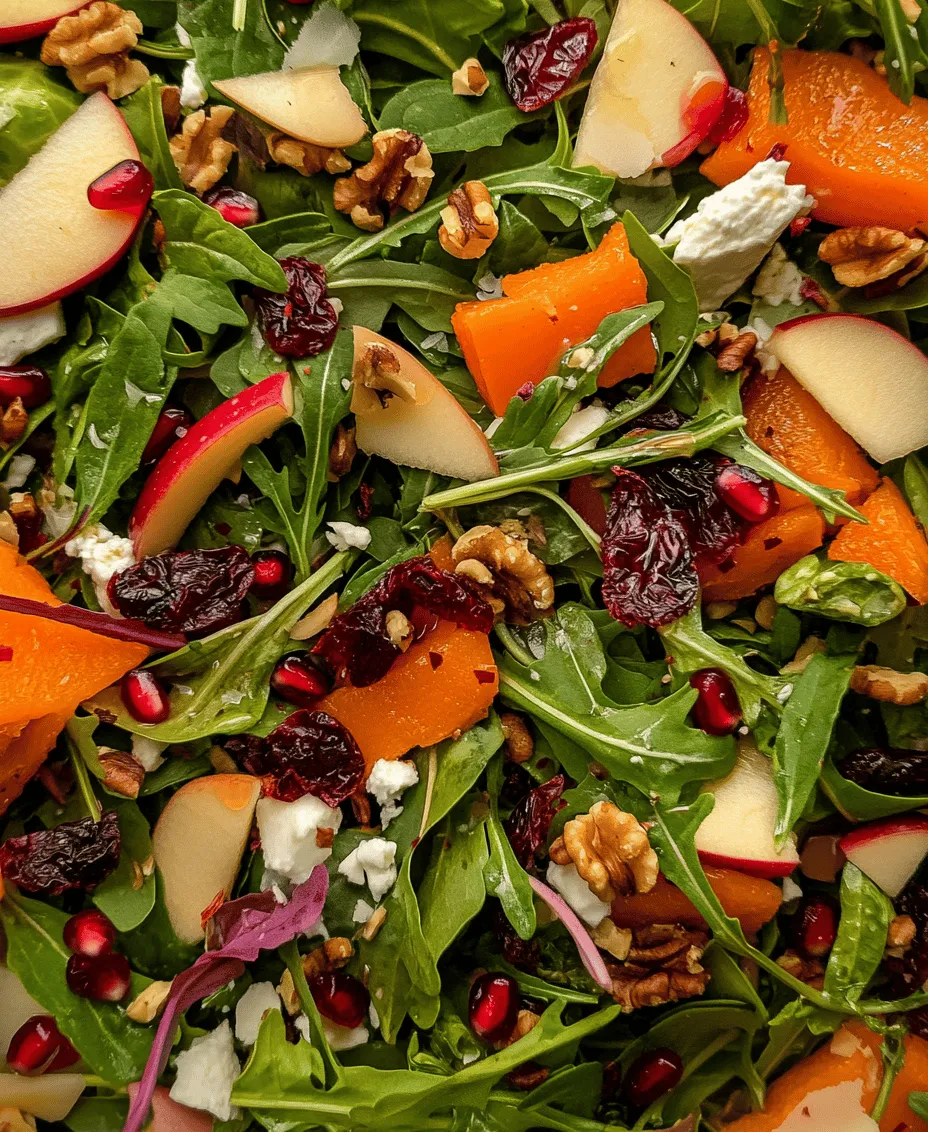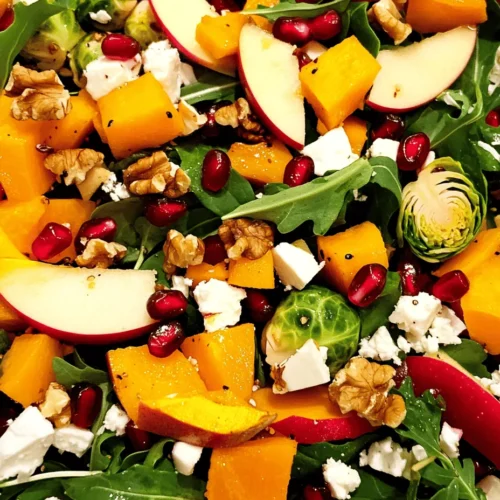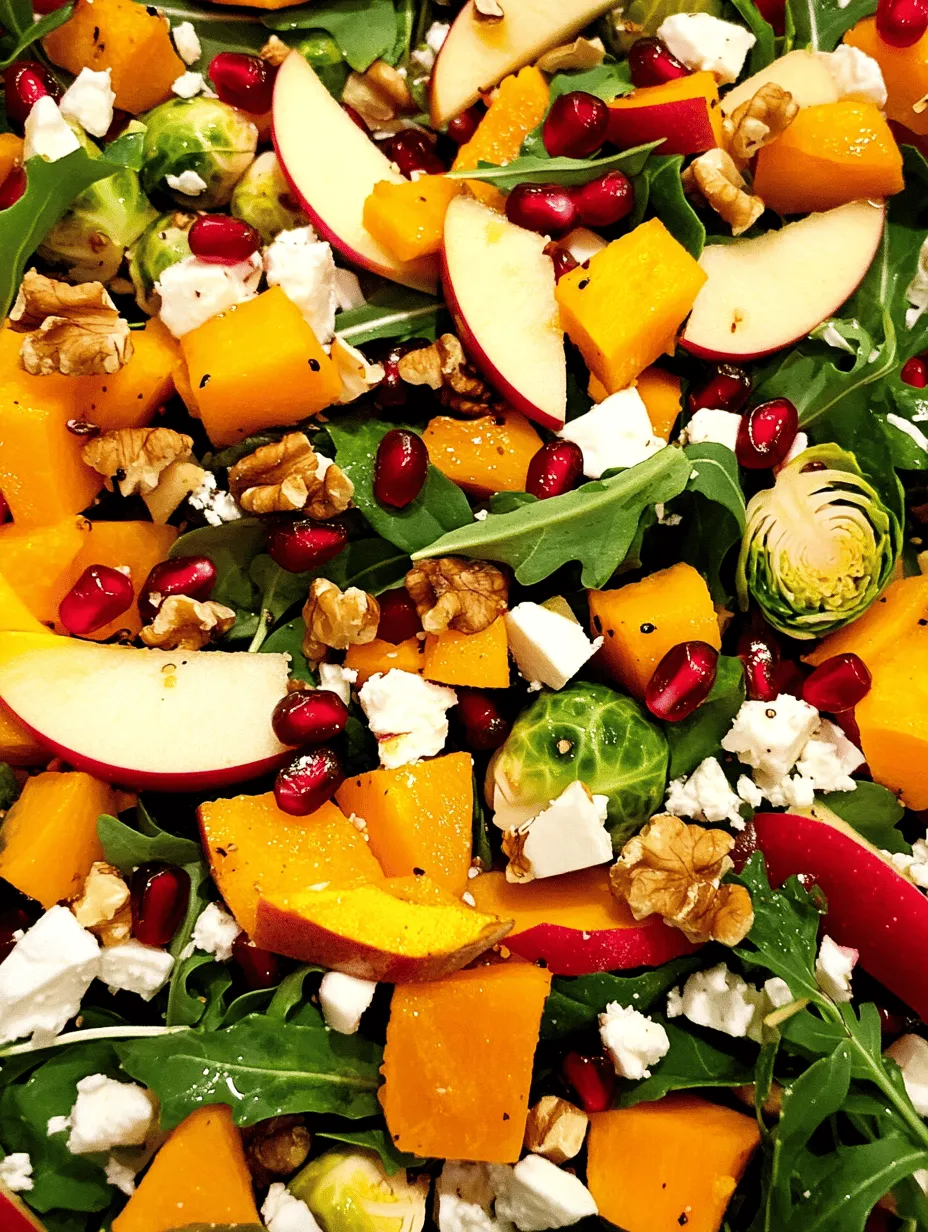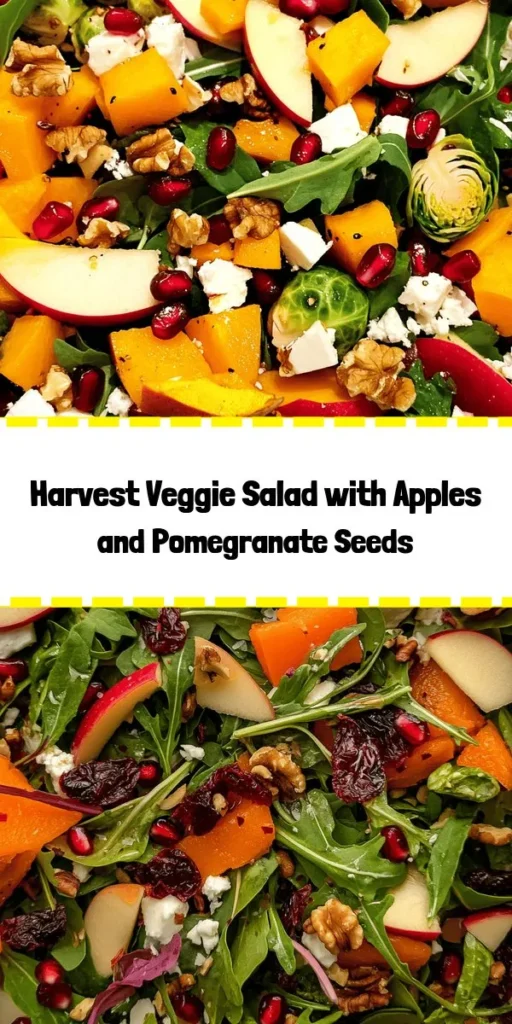As the leaves change colors and the air turns crisp, there’s no better way to celebrate the bounty of autumn than with a vibrant and nourishing Fall Harvest Salad. This delightful dish is not only a feast for the eyes but also a healthy option that showcases the best of the season’s produce. With its combination of mixed greens, roasted butternut squash, Brussels sprouts, and a sprinkling of sweet apples and cranberries, this salad embodies the essence of fall and provides a plethora of flavors and textures. Whether you’re hosting a Thanksgiving gathering or simply looking to enjoy a nutritious meal, the Fall Harvest Salad is a perfect choice.
Importance of Seasonal Ingredients
Utilizing seasonal ingredients is essential for creating dishes that are both delicious and nutrient-dense. Seasonal produce is at its peak in terms of flavor and freshness, often harvested at the height of ripeness. This not only ensures that your meals taste better but also supports local farmers and reduces your carbon footprint by minimizing transportation. The ingredients in the Fall Harvest Salad, such as butternut squash and Brussels sprouts, are not only readily available in autumn, but they also provide the comfort we seek during the cooler months. Embracing seasonal eating allows us to enjoy the natural cycles of nature while maximizing the nutritional benefits of our meals.
Nutritional Benefits of the Ingredients
A well-crafted Fall Harvest Salad is packed with nutrients that benefit your overall health. Each ingredient contributes a unique set of vitamins, minerals, and antioxidants that can boost your immune system and enhance your well-being. The combination of greens, squash, fruits, nuts, and cheese not only makes for a colorful dish but also ensures a balanced intake of essential nutrients. From fiber-rich vegetables to heart-healthy fats, this salad is designed to nourish your body while tantalizing your taste buds.
Appeal of the Salad for Autumn Gatherings
The Fall Harvest Salad is not only nutritious; it also serves as a stunning centerpiece for any autumn gathering. Its vibrant colors of deep greens, bright oranges, and rich reds create a visual feast that will impress your guests. Moreover, the combination of sweet, savory, and crunchy elements makes it a crowd-pleaser for both vegetarians and meat-lovers alike. As we gather around the table with family and friends during the fall season, this salad brings warmth and comfort, encouraging conversations and connections over delicious food.
Understanding the Ingredients
Mixed Greens: Benefits and Varieties
At the base of the Fall Harvest Salad lies a mixture of fresh greens, which are crucial for adding both flavor and texture. Popular varieties include arugula, spinach, and baby kale, each offering distinct tastes and nutritional benefits.
– Arugula: Known for its peppery flavor, arugula is rich in vitamins A, C, and K and provides a good amount of calcium and magnesium.
– Spinach: This leafy green is a powerhouse of nutrients, containing iron, folate, and antioxidants that support overall health.
– Baby Kale: Mild in flavor compared to mature kale, baby kale adds a tender crunch and is high in vitamins C and K.
These mixed greens not only enhance the salad’s flavor profile but also contribute to its overall health benefits, making every bite a nourishing experience.
Butternut Squash: A Fall Favorite
Butternut squash is a quintessential autumn ingredient that brings a touch of sweetness and warmth to the Fall Harvest Salad. This vibrant orange vegetable is packed with vitamins A and C, as well as dietary fiber, making it an excellent choice for promoting eye health and boosting the immune system.
The roasting process is key to enhancing the natural sweetness and flavor of butternut squash. As the squash caramelizes in the oven, it develops a rich, nutty taste that beautifully complements the other ingredients in the salad. To prepare butternut squash for your salad, simply peel, cube, and toss it with olive oil, salt, and pepper before roasting until golden and tender.
Brussels Sprouts: Nutritional Powerhouses
Brussels sprouts are another fall favorite, known for their unique flavor and impressive nutritional profile. These small, green veggies are packed with vitamins K and C, fiber, and antioxidants, making them a great addition to any healthy diet.
When it comes to cooking Brussels sprouts, roasting is one of the best methods. This technique helps to bring out their natural sweetness while achieving a crispy exterior. The slightly bitter taste of Brussels sprouts pairs exceptionally well with sweet ingredients like apples and dried cranberries, creating a balanced flavor in the salad that is both satisfying and nutritious.
Apples: The Sweet Crunch
No fall salad would be complete without the crisp, sweet crunch of apples. Selecting the right variety is essential for achieving the desired flavor and texture. Popular choices for salads include Honeycrisp, Gala, and Fuji, which offer a delightful sweetness that complements the savory elements of the salad.
Apples are not only delicious; they are also incredibly nutritious. Rich in dietary fiber and vitamin C, they support digestive health and provide a natural energy boost. Their crunchy texture adds a refreshing contrast to the roasted vegetables, making every bite of the Fall Harvest Salad an exciting experience.
Dried Cranberries: A Touch of Sweetness
Dried cranberries bring a burst of sweetness and a pop of color to the Fall Harvest Salad. These small, chewy fruits are not only delicious but also packed with antioxidants, especially proanthocyanidins, which may help support urinary tract health.
While adding dried cranberries can enhance the flavor of your salad, it’s essential to practice portion control, as they can be high in sugar. A small handful is enough to provide that desired sweetness without overwhelming the dish. Their tangy taste pairs beautifully with the other ingredients, making the salad both nutritious and satisfying.
Walnuts: Crunchy and Nutritious
Walnuts are a fantastic addition to the Fall Harvest Salad, providing a satisfying crunch and a wealth of nutritional benefits. They are an excellent source of omega-3 fatty acids, which are essential for heart health, as well as protein and fiber.
To maximize the flavor of walnuts, consider toasting them before adding them to the salad. Toasting enhances their nutty flavor and adds a delightful crunch that complements the other ingredients. Simply spread the walnuts on a baking sheet and toast them in the oven for a few minutes until golden and fragrant.
Feta Cheese: Creamy and Tangy
Feta cheese is a classic salad ingredient that adds a creamy, tangy flavor to the Fall Harvest Salad. This crumbly cheese is lower in calories and fat compared to many other cheeses, making it a healthier option while still delivering a rich taste.
Feta is rich in calcium and protein, contributing to the overall nutritional profile of the salad. If you are lactose intolerant or prefer a dairy-free option, consider substituting feta with crumbled tofu or a dairy-free cheese alternative that mimics the texture and flavor.
Pomegranate Seeds: A Burst of Flavor
Pomegranate seeds add a vibrant burst of color and flavor to the Fall Harvest Salad. These jewel-like seeds are not only stunning but also packed with nutrients, including vitamin C, potassium, and antioxidants.
In addition to their health benefits, pomegranate seeds provide a delightful crunch and a slightly tart flavor that balances the sweetness of other ingredients. They are typically in season during the fall and winter months, making them a perfect addition to your autumn-inspired salad.
With an understanding of these key ingredients, you are well-equipped to create a delicious and nutritious Fall Harvest Salad that celebrates the flavors of the season. Let’s dive into the step-by-step instructions to craft this seasonal dish that is sure to become a favorite at your autumn gatherings.

Tips for Extracting Seeds from a Pomegranate
Pomegranates are a delightful addition to the Fall Harvest Salad, providing a sweet burst of flavor and a vibrant pop of color. However, extracting seeds, or arils, from a pomegranate can be a daunting task if you’re unfamiliar with the process. Here are some simple tips to make the job easier:
1. Choose a Ripe Pomegranate: Look for one that feels heavy for its size, as this indicates it is full of juice. The skin should be firm and slightly shiny.
2. Cut the Pomegranate: Start by cutting the pomegranate in half horizontally. This method allows you to see the seeds clearly.
3. Use Water: Fill a bowl with water and submerge one half of the pomegranate. Gently pry the seeds out with your fingers. The seeds will sink to the bottom, while the pith will float, making it easy to separate the two.
4. Strain and Dry: Once you have collected all the seeds, strain them through a fine mesh sieve to remove any remaining pith and pat them dry with a paper towel.
5. Store Properly: If you have leftovers, store the seeds in an airtight container in the refrigerator for up to a week or freeze them for longer storage.
Preparing the Fall Harvest Salad
Step-by-Step Guide to Roasting Vegetables
Roasting vegetables is a cornerstone of this Fall Harvest Salad, bringing out their natural sweetness and enhancing their flavors. Here’s how to do it perfectly:
1. Preheat the Oven: Start by preheating your oven to 425°F (220°C). Preheating is crucial as it ensures that the vegetables begin cooking immediately, resulting in a nice caramelization.
2. Prepare the Vegetables: Choose seasonal vegetables such as butternut squash, Brussels sprouts, and carrots. Wash and peel as necessary, then cut them into uniform pieces for even roasting.
3. Season: Toss the vegetables with olive oil, salt, pepper, and any additional herbs (like thyme or rosemary) in a large bowl. Aim for a good coating but avoid making them too oily.
4. Spread on a Baking Sheet: Arrange the seasoned vegetables in a single layer on a baking sheet. Overcrowding the pan can lead to steaming rather than roasting, so use two pans if necessary.
5. Roast: Place the baking sheet in the preheated oven and roast for 20-30 minutes, flipping the vegetables halfway through. They should be golden brown and tender when done.
6. Check for Doneness: Use a fork to check the texture; it should easily pierce through the vegetables. If they need more time, continue roasting and check every five minutes.
Crafting the Perfect Dressing
The dressing can make or break a salad, and for this Fall Harvest Salad, we aim for a balance of flavors that complements the roasted vegetables and fresh greens.
1. Ingredients: Combine 1/4 cup of extra virgin olive oil, 2 tablespoons of apple cider vinegar, 1 tablespoon of Dijon mustard, and 1 teaspoon of honey or maple syrup in a small bowl.
2. Emulsification: To create a smooth dressing, whisk the ingredients vigorously while slowly adding the olive oil. This process combines the oil and vinegar, creating a creamy consistency without separation.
3. Taste and Adjust: Don’t forget to taste your dressing. Adjust the acidity by adding more vinegar or sweetness with additional honey, depending on your preference.
Assembling the Salad: A Visual Guide
Once your ingredients are ready—roasted vegetables, fresh greens, pomegranate seeds, and dressing—it’s time to assemble your salad.
1. Layering Ingredients: Start with a base of mixed greens in a large salad bowl. Add a generous layer of roasted vegetables on top, followed by a sprinkle of pomegranate seeds.
2. Add Cheese and Nuts: If desired, crumble feta or goat cheese over the top, and sprinkle with toasted nuts for added crunch and flavor.
3. Tossing the Salad: To avoid bruising the greens, use two large serving spoons to gently lift and turn the salad instead of tossing it aggressively.
Serving Suggestions
Presentation Ideas for Fall Gatherings
The appeal of the Fall Harvest Salad goes beyond taste; its vibrant colors and textures make it visually stunning. Here are some tips for an impressive presentation:
– Use a Clear Serving Bowl: A glass or clear bowl showcases the colorful ingredients beautifully.
– Garnish: Consider garnishing with fresh herbs like parsley or mint for a burst of color.
– Layering: Serve in individual bowls with layers visible, or create a layered salad in a jar for a unique touch.
Pairing Suggestions
Completing your meal alongside the Fall Harvest Salad enhances the dining experience. Here are some great pairings:
– Main Dishes: Serve with roasted chicken, grilled salmon, or a hearty quinoa dish for a balanced meal.
– Wine Pairings: A crisp white wine, such as Sauvignon Blanc or a light red like Pinot Noir, complements the salad’s flavors perfectly.
Health Benefits of the Fall Harvest Salad
This Fall Harvest Salad isn’t just delicious; it also brings numerous health benefits:
Nutritional Analysis of the Salad
With a combination of greens, vegetables, and seeds, this salad is packed with nutrients. A typical serving contains:
– Calories: Approximately 250-300 calories per serving, depending on the amount of dressing and cheese used.
– Macronutrients: Rich in carbohydrates from the vegetables, healthy fats from olive oil and nuts, and protein from cheese.
Benefits of Fiber-Rich Ingredients for Digestion
The variety of vegetables and greens in this salad contributes to a high fiber content, promoting digestive health and helping maintain a healthy weight.
How the Salad Supports Seasonal Eating
Eating seasonal produce not only supports local farmers but also ensures that you are consuming the freshest ingredients. Seasonal eating has several benefits:
– Nutritional Value: Seasonal fruits and vegetables are often more nutrient-dense as they are harvested at their peak.
– Environmental Impact: Consuming local produce reduces carbon footprints associated with transportation.
Conclusion: Embracing Autumn with Flavor and Nutrition
The Fall Harvest Salad is a celebration of autumn’s bounty, combining flavors, colors, and textures that resonate with the season. This salad not only offers a delightful dining experience but also encourages you to embrace seasonal ingredients for better health.
As you gather with loved ones during this cozy season, remember that sharing meals rich in flavor and nutrition fosters connections. Enjoy the process of preparing this vibrant salad, and let it be a centerpiece for your fall gatherings. Whether you’re serving it at a family dinner or a festive gathering, the Fall Harvest Salad is sure to impress and nourish all who partake.



